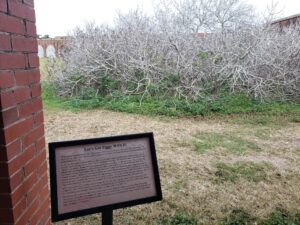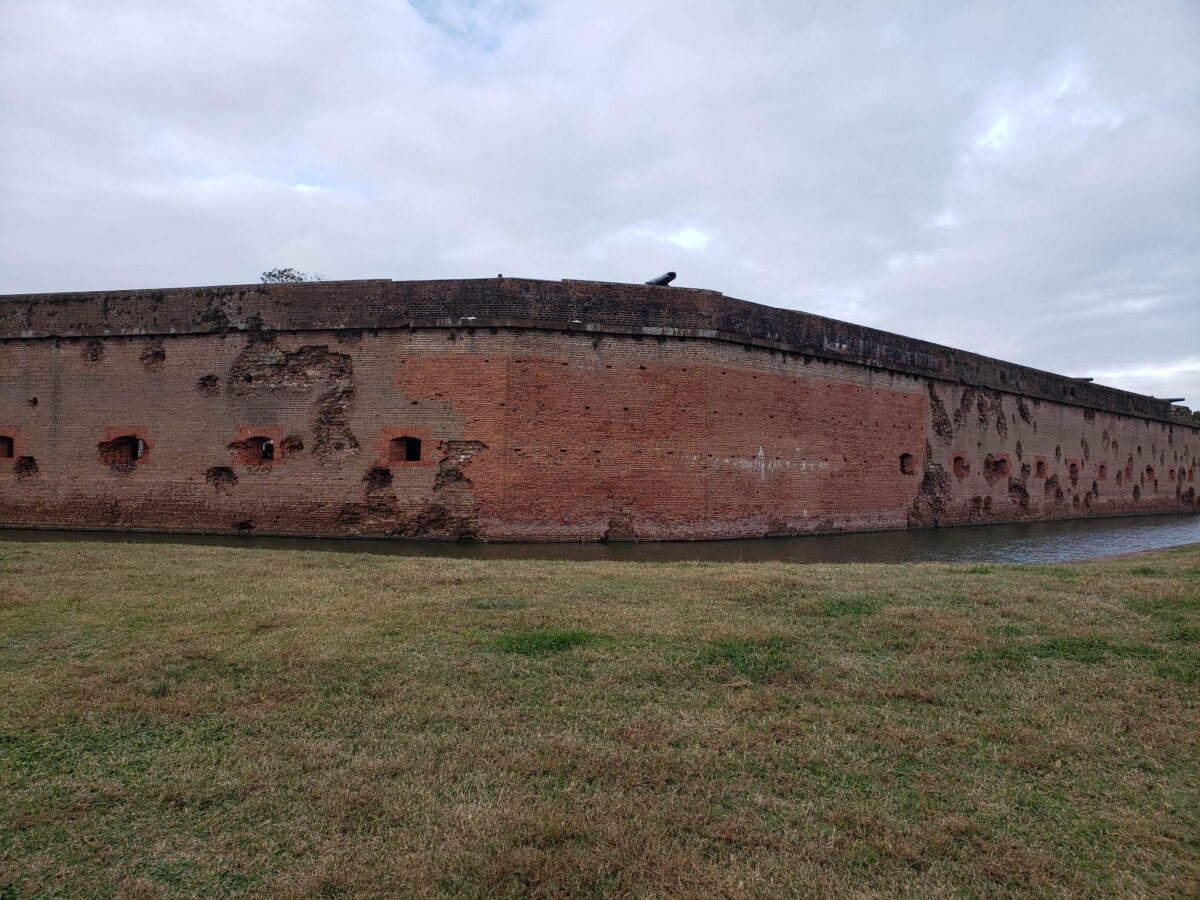by Bryan & Heather
Thanksgiving 2022 saw a change of pace for us. After years of celebrating the holiday quietly (minus the sound of Bryan bustling around the kitchen all day), this time we embarked on a weekend trip to Savannah, Georgia, currently home to Bryan’s brother and locus of the first Caswell Thanksgiving in quite a while. Our trip was largely flexible; we knew there was a lot to see in the city, but nothing so can’t-miss as to map out our entire time in advance. One attraction we knew we would make it to at some point, however, was Fort Pulaski. A masonry coastal fort guarding the approach to Savannah designed and built in the nineteenth century, Pulaski was young Robert E. Lee’s first engineering assignment and the site of early Civil War action. As the skies cleared on our last full day in the region, we finally made the drive out across channel and causeway to this island fortress.
Surrounded by tidal plains threaded with miles of trails, Fort Pulaski was easily one of the most vacation-worthy sites we have visited, especially if you can avoid the frequent coastal storms that visit the region. Pulling up the long drive, the fort itself was every bit as imposing as its original architects hoped, its edifice towering above the coastal scrub encircled by a wide moat that signs warned visitors could play host to alligators. Pulaski had certainly passed the aesthetic test, but what about its history? Each of us had some passing familiarity with the significance of the site; Bryan had read of its capture in the context of the Union blockade, effectively closing the port of Savannah for Southern shipping, while Heather had learned of the fort’s role as a prison for Southern POWs during her time at Andersonville. As we entered the visitors’ center, however, we found only the barest hint of these two avenues of interpretation.

Instead, Fort Pulaski’s overwhelming historical focus lay in the realm of artillery–fitting for our group, as it turned out, accompanied as we were by Bryan’s brother and modern artillery officer, Matt. According to the museum, the bombardment of Pulaski in 1862 was the first true test of rifled artillery in the American Civil War, to resounding effect. What had been considered an invincible fortification only years previously was successfully reduced in the space of thirty hours using only long-range bombardment, largely out of range of the fort’s batteries. An interesting bit of technological and tactical history, even if we might have preferred to see some more interpretation of other themes. The problem with this approach, however, became apparent as we entered the fort. While the structure itself proved remarkably well maintained, replete with the mandatory layout of barracks, officers quarters, mess, chapel, and other rooms kept as they would have been furnished in the 1860s, there had been negligible attempts to recreate the actual conditions of the bombardment. Only a single token timber casemate could be seen against the walls, when the fort would have been covered with them. No evidence of actual human habitation or martial preparation beyond the sporadic ordnance that lined the ramparts could be found (and an opportunity to interpret the ingenious gun carriages, which delighted Matt, was missed as well). There wasn’t even any effort to orient visitors to the direction from which the Union bombardment would have come in 1862; it was only through their own orientation and a stroll around the outside of the fort to assess its damage could Bryan and Matt figure it out for themselves.

All this left us with a strange feeling for visiting a National Park site: thoroughly pleased with our outing, but underwhelmed by the power of the place we had just toured. While many battlefields moonlight as community recreation parks, Pulaski felt almost like a recreational area that moonlighted as an historical site. We couldn’t help but feel like this stemmed from its choice to interpret an essentially passive event. If the significance of Pulaski was the ascent of rifled artillery, then it really had nothing to do with the place we were standing at all; in theory, any of the forts along the Southern coast could have fallen in that fashion, and without the ability to picture the fort under bombardment, the endurance of its defenders, or even the view of its attackers as they wheeled their batteries into position, the whole experience felt oddly empty. In the final accounting, Pulaski felt like a site that it was almost necessary to read about beforehand to truly appreciate beyond its simple coastal beauty. While we thoroughly enjoyed our picturesque ramble along its ramparts that cloudy afternoon, it unfortunately was a highlight of our time in Savannah in spite of, rather than on account of, its history.
